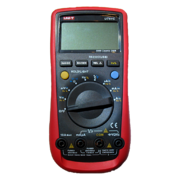Difference between revisions of "UNI-T UT61C"
Uwe Hermann (talk | contribs) m |
SmithChart (talk | contribs) (Add hints on how to use this device. Mostly: Because it took me about 2 hours to figure out how to activate remote transmission on this devices. Examples are based on the UT61E page.) |
||
| Line 45: | Line 45: | ||
See [[Device cables#UNI-T_UT-D04]]. | See [[Device cables#UNI-T_UT-D04]]. | ||
== Usage == | |||
The DMM does not transmit samples after power up. | |||
You need to long-press the <tt>REL Δ</tt> button to activate the remote measurement. | |||
This also deactivates the auto power-off function of the device. | |||
The following [[sigrok-cli]] command can be used to receive five measured values from a device connected via USB (note that the USB VID/PID after the '''<tt>conn</tt>''' option needs to be changed depending on the exact USB adapter cable used): | |||
<source lang="bash"> | |||
$ sigrok-cli --driver=uni-t-ut61c:conn=1a86.e008 -O analog --samples 5 | |||
</source> | |||
If your meter has a serial (RS-232) cable connected to a USB-to-serial adapter, a different driver is used. Example for ttyUSB0: | |||
<source lang="bash"> | |||
$ sigrok-cli --driver=uni-t-ut61c-ser:conn=/dev/ttyUSB0 -O analog --samples 5 | |||
</source> | |||
Same example for COM1 (Windows), please note the special syntax for specifying the COM port: | |||
<source lang="text"> | |||
C:\> sigrok-cli --driver=uni-t-ut61c-ser:conn=\\.\COM1 -O analog --samples 5 | |||
</source> | |||
'''<tt>--samples <n></tt>''' stops acquisition after the specified number of measurements, while '''<tt>--continuous</tt>''' does not stop. Type just '''sigrok-cli''' by itself for a summary of options. | |||
More information on drivers can be found in the [http://sigrok.org/gitweb/?p=libsigrok.git;a=blob;f=README.devices README.devices] file of the [[libsigrok]] source tree. | |||
== Protocol == | == Protocol == | ||
Latest revision as of 09:54, 8 March 2022
 | |
| Status | supported |
|---|---|
| Source code | uni-t-dmm |
| Counts | 6000 |
| IEC 61010-1 | CAT II (600V) / CAT III (300V) |
| Connectivity | RS232 / USB |
| Measurements | voltage, current, resistance, capacitance, frequency, duty cycle, diode, continuity, temperature |
| Features | autorange, data hold, min/max, rel, bargraph, backlight |
| Website | uni-trend.com |
The UNI-T UT61C is a 6000 counts, CAT II (600V) / CAT III (300V) handheld digital multimeter with RS232 or USB connectivity.
See UNI-T UT61C/Info for more details (such as lsusb -v output) about the device.
Hardware
Multimeter:
- Multimeter IC: Fortune Semiconductor FS9922-DMM4 (datasheet)
- Crystal: 4MHz (markings: "3.999")
- Fuses: 10A/240V and 1A/240V (HRV fuses)
RS232 cable:
See Device cables#UNI-T_UT-D02.
USB cable:
See Device cables#UNI-T_UT-D04.
Photos
Multimeter:
RS232 cable:
See Device cables#UNI-T_UT-D02.
USB cable:
See Device cables#UNI-T_UT-D04.
Usage
The DMM does not transmit samples after power up. You need to long-press the REL Δ button to activate the remote measurement. This also deactivates the auto power-off function of the device.
The following sigrok-cli command can be used to receive five measured values from a device connected via USB (note that the USB VID/PID after the conn option needs to be changed depending on the exact USB adapter cable used):
$ sigrok-cli --driver=uni-t-ut61c:conn=1a86.e008 -O analog --samples 5
If your meter has a serial (RS-232) cable connected to a USB-to-serial adapter, a different driver is used. Example for ttyUSB0:
$ sigrok-cli --driver=uni-t-ut61c-ser:conn=/dev/ttyUSB0 -O analog --samples 5
Same example for COM1 (Windows), please note the special syntax for specifying the COM port:
C:\> sigrok-cli --driver=uni-t-ut61c-ser:conn=\\.\COM1 -O analog --samples 5
--samples <n> stops acquisition after the specified number of measurements, while --continuous does not stop. Type just sigrok-cli by itself for a summary of options. More information on drivers can be found in the README.devices file of the libsigrok source tree.
Protocol
See Multimeter_ICs#Fortune_Semiconductor_FS9922-DMM4 for the DMM IC protocol. Depending on the cable, additional transport-specific decoding is needed, though.